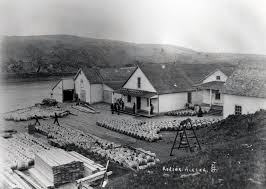
By Discover Kodiak
In 1741, members of Vitus Bering’s second voyage through the Gulf of Alaska set foot on Alaska soil, marking the beginning of Russian sovereignty in the state. Kodiak Islanders enjoyed a few more years of peace when more explorers came to the region but passed by Kodiak Island. They did not return until 1762, when a Russian fur trader made a brief visit but quickly retreated after the Kodiak people discouraged his presence.
The people of Kodiak Island maintained their independence until 1784, when Grigori Shelikhov arrived here. Shelikov recognized that Kodiak had abundant resources, protected bays and rich hunting grounds for sea otters. Despite efforts by the Alutiiq people to repel him, Shelikov was determined to establish a permanent settlement on the archipelago. Bringing with him modern artillery and a fiery disposition, Shelikov subdued the islanders, marking a new era on Kodiak Island.
He chose a secluded harbor on Kodiak’s southeast side near present-day Old Harbor, which he named Three Saints Bay. With his settlement underway, Shelikov swiftly initiated an economy based on compulsory labor, pressing the Alutiiq Natives into hunting sea otter for his company. Russian activity on the archipelago expanded and, in 1792, company manager Alexander Baranov established what would become the first capital of Russia-America at St. Paul’s Harbor (now modern Kodiak.)
Many streets in Kodiak are named after Russians; many inhabitants with indigenous Alutiiq blood bear Russian family names; and the Russian Orthodox church, built in 1898, is a major landmark with its pretty twin blue cupolas.
As Russian occupation expanded, Kodiak became the commercial center of Russian trade. Baranov, by then governor of Russian America, built an otter-pelt warehouse, or magazin, on a hill looking over what is now St. Paul Harbor. Two hundred years later, the building still stands and is the Baranov Museum. The museum’s collection includes prehistoric Native artifacts, remnants of Russian colonization, mementos of territorial days and WWII memorabilia.
The most-lasting legacy of the Russian era is the Russian Orthodox religion. With its distinctive blue cupolas, the Holy Resurrection Russian Orthodox Cathedral is a prominent fixture in downtown Kodiak. It houses the reliquary of St. Herman, who was canonized at the church in 1970.
After Baranov’s departure and death, his settlement in Alaska began to falter. As sea-otter populations declined, so did profits, and the weary Russians saw a way out by selling to the United States. In 1867, the U.S. purchased Alaska for $7.2 million, or about two cents per acre. Kodiak’s economy shifted from the fur trade to fisheries. Salmon became the economic staple, and salteries and canneries dotted the islands by the 1890s. Commercial fishing remains the economic mainstay of Kodiak today.




